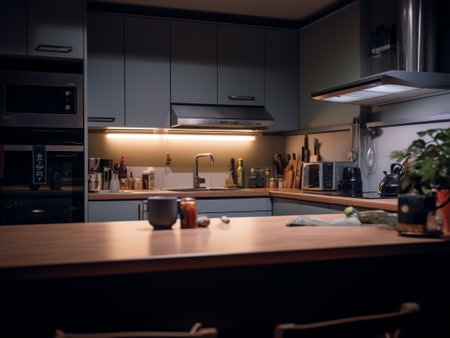Understanding Kitchen Island Lighting Needs
When it comes to designing the heart of the home, kitchen island lighting plays a pivotal role in both function and style. In many American homes, the kitchen island serves as a multi-purpose hub: it’s where families gather for breakfast, kids do their homework, and guests mingle during parties. Proper lighting ensures that these activities are comfortable and enjoyable while adding a distinct visual appeal to your space. Kitchen island lighting isn’t just about making tasks easier—it’s also an opportunity to express your personal style and enhance your home’s overall aesthetic. By understanding the unique needs of your kitchen island area, you can select fixtures that deliver the right balance of brightness and beauty, making your kitchen truly shine.
Types of Kitchen Island Light Fixtures
When it comes to kitchen island lighting, choosing the right type of fixture can make all the difference in both functionality and style. There are several popular options that American homeowners often consider, each with its own unique advantages. Below is a breakdown of the most common kitchen island lighting types and what sets them apart.
Pendant Lights
Pendant lights are a classic choice for kitchen islands. They hang down from the ceiling and provide focused light directly over the island workspace. Pendant lights come in various shapes, sizes, and materials, making it easy to find a style that fits your home’s vibe—whether you’re going for modern farmhouse or sleek contemporary.
Chandeliers
If you want to make a statement, chandeliers offer both elegance and ample illumination. While traditionally associated with dining rooms, many Americans now use mini-chandeliers or linear chandeliers above their kitchen islands for a touch of glamour. They work especially well in larger kitchens where high ceilings allow room for bigger fixtures.
Recessed Lighting
For those who prefer a minimalist look, recessed lighting is a go-to option. Installed flush with the ceiling, these fixtures provide even, unobtrusive light across the island. Recessed lights are great for open-concept kitchens or when you want to highlight other decorative features without distraction.
Comparison Table: Popular Kitchen Island Lighting Types
| Lighting Type | Main Advantages | Best For |
|---|---|---|
| Pendant Lights | Focused task lighting, wide variety of designs, easy to customize layout | Most kitchen islands; flexible styling |
| Chandeliers | Decorative impact, broad illumination, adds sophistication | Large islands, kitchens with high ceilings |
| Recessed Lighting | Sleek and subtle appearance, even light distribution, low maintenance | Modern kitchens, open layouts |
Ultimately, your choice will depend on your kitchen’s size, layout, and personal style. The right combination of fixtures can elevate both the look and functionality of your space.
![]()
3. Finding the Right Size and Scale
Choosing kitchen island lighting isn’t just about style; it’s also about making sure your fixtures fit both your island and your room’s proportions. Getting the size and scale right ensures your lights look balanced, provide enough illumination, and don’t overwhelm or underwhelm your space. Here are some essential tips to guide you:
Consider Your Island’s Dimensions
Measure the length and width of your kitchen island before shopping for fixtures. A good rule of thumb is to leave at least 6-12 inches from the edge of the fixture to the edge of your island on both sides. For example, if your island is 6 feet long, aim for a total light fixture width (or combined widths if using multiple pendants) of around 3-4 feet.
Choose Fixture Quantity and Spacing Wisely
If you’re going with multiple pendants, space them evenly to create visual harmony. Typically, two or three pendants work best for most islands. Leave about 24-30 inches between each pendant center to prevent overcrowding and ensure even lighting coverage.
Pay Attention to Hanging Height
The ideal hanging height for kitchen island lighting is usually 30-36 inches above the countertop. This provides ample task lighting while maintaining clear sightlines across the kitchen. If you have higher ceilings (over 9 feet), consider raising fixtures an extra 3 inches for every additional foot of ceiling height.
Don’t Forget Ceiling Height
Your ceiling height impacts both fixture size and hanging length. For standard 8-foot ceilings, choose more compact fixtures and stick to standard hanging heights. For vaulted or high ceilings, larger statement pieces can work beautifully—just make sure they’re proportionate to both your island and overall kitchen space.
Pro Tip: Test Before You Commit
If possible, use painter’s tape or cardboard cutouts to mark out potential fixture sizes above your island before purchasing. This quick mock-up gives you a real sense of how different sizes will look in your actual space, helping you avoid costly mistakes and ensuring a perfect fit.
4. Choosing the Perfect Style
When it comes to kitchen island lighting, selecting a style that complements your kitchen’s overall décor is key. The right fixture can tie the entire room together and even become a stunning focal point. Whether your space leans modern, farmhouse, or traditional, there’s a perfect lighting solution for you. Consider the following advice as you narrow down your choices:
Match Lighting to Your Kitchen Style
| Kitchen Style | Recommended Fixtures | Key Design Features |
|---|---|---|
| Modern | Pendants with clean lines, geometric shapes, metallic finishes | Sleek silhouettes, minimal embellishments, neutral colors |
| Farmhouse | Mason jar lights, lantern pendants, rustic chandeliers | Distressed finishes, wood or wrought iron elements, warm tones |
| Traditional | Classic glass shades, ornate chandeliers, antique-inspired fixtures | Decorative details, soft curves, timeless materials like brass or bronze |
Tips for Coordinating Your Lighting Choice
- If your kitchen features mixed metals or hardware finishes, choose fixtures that incorporate those same tones for a cohesive look.
- For open-concept homes, coordinate your kitchen island lighting with adjacent dining or living areas for visual harmony.
- If you want your island to stand out, go bold with statement pieces or contrasting styles—just keep other elements simple to avoid clashing.
Consider Fixture Scale and Arrangement
The style isn’t just about looks—it’s also about proportion. For large islands, consider using multiple pendants or an elongated linear fixture. Smaller islands often benefit from a single statement pendant. Make sure the size and number of lights suit both your island and the rooms ceiling height.
Your Unique Touch
No matter the trend, your personal taste matters most. Choose lighting that speaks to you while respecting your kitchen’s character—this blend of style and individuality ensures your kitchen feels both functional and inviting.
5. Light Placement and Layering
Getting the placement of your kitchen island lighting right is essential for both practical use and visual harmony. Start by considering the primary function of your island—whether it’s used mainly for food prep, casual dining, or as a gathering spot. For optimal task lighting, position fixtures directly above the work areas, generally spacing pendants about 24-30 inches apart and ensuring they hang 30-36 inches above the countertop. This prevents harsh shadows while keeping the space bright and usable.
Layering light sources is key to achieving a balanced and inviting atmosphere. Combine focused task lighting, such as pendant lights or linear chandeliers, with ambient options like recessed ceiling lights or dimmable LED strips under cabinets. This approach allows you to adapt the mood and functionality of your kitchen throughout the day—bright and energizing for cooking, softer and cozier for entertaining guests.
For larger islands or open-concept layouts, consider integrating accent lighting to highlight architectural features or decorative elements. Don’t forget about dimmer switches; they offer flexibility and let you transition seamlessly between different activities. By thoughtfully layering and positioning your kitchen island lighting, you’ll create a space that’s both visually stunning and highly functional—a perfect blend for any American home.
6. Energy Efficiency and Smart Features
When choosing kitchen island lighting for your American home, energy efficiency and smart features are more important than ever. Modern kitchens often use LED fixtures, which are known for their long lifespan and low energy consumption. LEDs not only help reduce your electricity bill but also offer a variety of color temperatures and brightness levels to match any kitchen style. For even more versatility, consider dimmable lighting options. These let you adjust the light intensity according to your needs—brighter for food prep, softer for entertaining or late-night snacks. Smart lighting solutions take convenience a step further. With Wi-Fi or Bluetooth-enabled fixtures, you can control your kitchen island lights from your smartphone or with voice commands through popular smart home systems like Alexa or Google Home. Some smart bulbs even allow you to change colors or set schedules, creating the perfect ambiance at any time of day. By focusing on energy-efficient, dimmable, and smart lighting options, you’ll create a modern kitchen that’s both stylish and practical for today’s eco-conscious American lifestyle.


